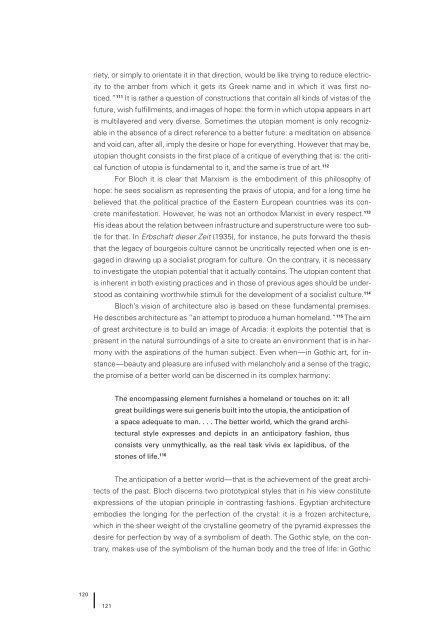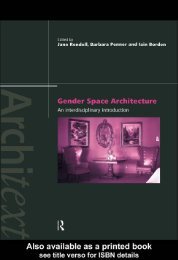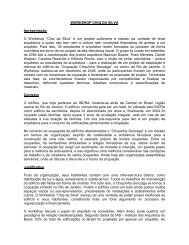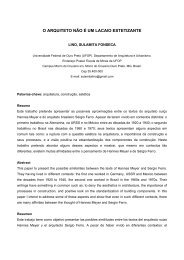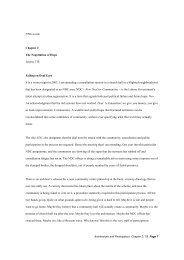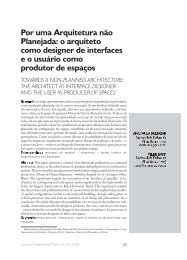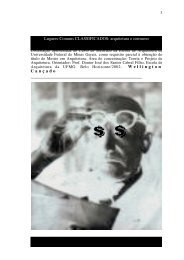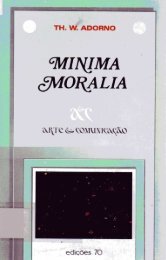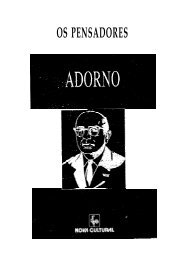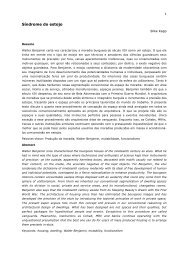Architecture and Modernity : A Critique
Architecture and Modernity : A Critique
Architecture and Modernity : A Critique
You also want an ePaper? Increase the reach of your titles
YUMPU automatically turns print PDFs into web optimized ePapers that Google loves.
120<br />
riety, or simply to orientate it in that direction, would be like trying to reduce electricity<br />
to the amber from which it gets its Greek name <strong>and</strong> in which it was first noticed.”<br />
111 It is rather a question of constructions that contain all kinds of vistas of the<br />
future, wish fulfillments, <strong>and</strong> images of hope: the form in which utopia appears in art<br />
is multilayered <strong>and</strong> very diverse. Sometimes the utopian moment is only recognizable<br />
in the absence of a direct reference to a better future: a meditation on absence<br />
<strong>and</strong> void can, after all, imply the desire or hope for everything. However that may be,<br />
utopian thought consists in the first place of a critique of everything that is: the critical<br />
function of utopia is fundamental to it, <strong>and</strong> the same is true of art. 112<br />
For Bloch it is clear that Marxism is the embodiment of this philosophy of<br />
hope: he sees socialism as representing the praxis of utopia, <strong>and</strong> for a long time he<br />
believed that the political practice of the Eastern European countries was its concrete<br />
manifestation. However, he was not an orthodox Marxist in every respect. 113<br />
His ideas about the relation between infrastructure <strong>and</strong> superstructure were too subtle<br />
for that. In Erbschaft dieser Zeit (1935), for instance, he puts forward the thesis<br />
that the legacy of bourgeois culture cannot be uncritically rejected when one is engaged<br />
in drawing up a socialist program for culture. On the contrary, it is necessary<br />
to investigate the utopian potential that it actually contains. The utopian content that<br />
is inherent in both existing practices <strong>and</strong> in those of previous ages should be understood<br />
as containing worthwhile stimuli for the development of a socialist culture. 114<br />
Bloch’s vision of architecture also is based on these fundamental premises.<br />
He describes architecture as “an attempt to produce a human homel<strong>and</strong>.” 115 The aim<br />
of great architecture is to build an image of Arcadia: it exploits the potential that is<br />
present in the natural surroundings of a site to create an environment that is in harmony<br />
with the aspirations of the human subject. Even when—in Gothic art, for instance—beauty<br />
<strong>and</strong> pleasure are infused with melancholy <strong>and</strong> a sense of the tragic,<br />
the promise of a better world can be discerned in its complex harmony:<br />
121<br />
The encompassing element furnishes a homel<strong>and</strong> or touches on it: all<br />
great buildings were sui generis built into the utopia, the anticipation of<br />
a space adequate to man. . . . The better world, which the gr<strong>and</strong> architectural<br />
style expresses <strong>and</strong> depicts in an anticipatory fashion, thus<br />
consists very unmythically, as the real task vivis ex lapidibus, of the<br />
stones of life. 116<br />
The anticipation of a better world—that is the achievement of the great architects<br />
of the past. Bloch discerns two prototypical styles that in his view constitute<br />
expressions of the utopian principle in contrasting fashions. Egyptian architecture<br />
embodies the longing for the perfection of the crystal: it is a frozen architecture,<br />
which in the sheer weight of the crystalline geometry of the pyramid expresses the<br />
desire for perfection by way of a symbolism of death. The Gothic style, on the contrary,<br />
makes use of the symbolism of the human body <strong>and</strong> the tree of life: in Gothic


